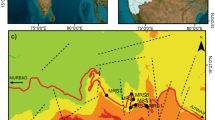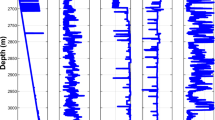Abstract
All numerical and analytical methods dealing with the calculating deformation of rock mass require deformation modulus (Df) which is measured by direct or estimated by indirect approaches. Direct methods such as plate loading, flat jack, and dilatometer test have been developed, but they are generally expensive, time-consuming, and sometimes questionable. Furthermore, Df data is often limited and insufficient to estimate its statistics or not being available at all in many rock engineering projects. The empirical approach, as a practical tool, seems attractive and an alternative approach for Df determination. This experimental study presents a new empirical correlation set for the Df estimation based on 73 dilatometer tests, 27 laboratory tests, and related rock quality designation (RQD) which belonged to several dam/hydro-power projects. The statistical method and regression approach were used to analyze the data to develop a new correlation set in which about 70% of the database gathered for Df equations development and the remaining data (30%) for its validation process. Data were used to developing of the new empirical equation set; generally belong to the fair to good quality rock masses. The input data for the Df estimation consist of laboratory elasticity modulus (El), RQD, and loading level factor (\({\text{B}}_{{\text{n}}}\)). The statistical analysis revealed that Df has a significant dependence on the loading level factor. Also, El and in-situ elasticity modulus (\({\text{E}}_{{\text{f}}}\)) would have the best correlation if the laboratory specimen was achieved from the dilatometer test zone. The R-square (\(R^{2}\) = 0.91) and the mean absolute relative prediction error (MARPE about 20%) verified the new correlation set. Finally, the estimated total deformation modulus from this paper’s relation set compared with the deformation modulus achieved from two existing empirical equations, and the main cause of differences was discussed.













Similar content being viewed by others
References
AASHTO (1989) Standard specifications for highway bridges, 14th edn. Association of State Highway and Transportation Officials, Washington
Asadizadeh M, Hossaini MF (2016) Predicting rock mass deformation modulus by artificial intelligence approach based on dilatometer tests. Arab J Geosci 9(2):96
ASTM (2004) Annual Book of ASTM Standards, 2004: Soil and Rock; Vol. 4.08. American Society for Testing & Materials
Barton N (2002) Some new Q-value correlations to assist in site characterisation and tunnel design. Int J Rock Mech Min Sci 39(2):185–216
Bieniawski ZT (1978) Determining rock mass deformability: experience from case histories. In: International journal of rock mechanics and mining sciences & geomechanics abstracts, vol 15, no 5. Pergamon, pp 237–247
Bieniawski ZT (1989) Engineering rock mass classifications: a complete manual for engineers and geologists in mining, civil, and petroleum engineering. Wiley, New York
Chun BS, Ryu WR, Sagong M, Do JN (2009) Indirect estimation of the rock deformation modulus based on polynomial and multiple regression analyses of the RMR system. Int J Rock Mech Min Sci 46(3):649–658
Clerici A (1993) Indirect determination of the modulus of deformation of rock masses-case histories. In: ISRM international symposium-EUROCK 93. International Society for Rock Mechanics and Rock Engineering
Coon RF, Merritt AH (1970) Predicting in-situ modulus of deformation using rock quality indexes. In: Determination of the in-situ modulus of deformation of rock. ASTM International
Deere DU, Hendron AJ, Patton FD, Cording EJ (1966) Design of surface and near-surface construction in rock. In: The 8th US symposium on rock mechanics (USRMS)
Dershowitz W, Baecher G, Einstein H (1979) Prediction of rock mass deformability. In: 4th ISRM congress. International Society for Rock Mechanics and Rock Engineering
Ebisu S, Aydan Ö, Komura S, Kawamoto T (1994) (1994) Characterization of jointed rock masses for rock anchors. Doboku Gakkai Ronbunshu 505:267–276
Feng XT (ed) (2017) Rock mechanics and engineering volume 2: laboratory and field testing. CRC Press, Cambridge
Gage JR, Wang HF, Fratta D, Turner AL (2014) In-situ measurements of rock mass deformability using fiber Bragg grating strain gauges. Int J Rock Mech Min Sci 71:350–361
Galera JM, Álvarez M, Bieniawski ZT (2007) Evaluation of the deformation modulus of rock masses using RMR: comparison with dilatometer tests. In: Proceedings ISRM workshop, pp 71–77
Gardner WS (1987) Design of drilled piers in the Atlantic Piedmont. In: Foundations and excavations in decomposed rock of the Piedmont Province. ASCE, pp 62–86
Goodman RE (1989) Introduction to rock mechanics, vol 2. Wiley, New York
Grimstad E (1993) Updating the Q-system for NMT. In: Proceedings of the international symposium on sprayed concrete-modern use of wet mix sprayed concrete for underground support, Fagemes, Oslo, Norwegian Concrete Association
Harrison JP (1999) Selection of the threshold value in RQD assessments. Int J Rock Mech Min Sci 36(5):673–685
Hoek E, Brown ET (1997) Practical estimates of rock mass strength. Int J Rock Mech Min Sci 34(8):1165–1186
Hoek E, Diederichs MS (2006) Empirical estimation of rock mass modulus. Int J Rock Mech Min Sci 43(2):203–215
Interfels (2002) Dilatometer system, Boart Longyear interfels Gmbh, available at http://www.interfels.com.
IWPCO (Iran Water and Power Company) (1998) Laboratory and In-situ test report in Rock Mechanics, and Geotechnical Logging report
Kang SS, Kim HY, Jang BA (2013) Correlation of in-situ modulus of deformation with degree of weathering, RMR and Q-system. Environ Earth Sci 69(8):2671–2678
Kayabasi A, Gokceoglu CANDAN, Ercanoglu MURAT (2003) Estimating the deformation modulus of rock masses: a comparative study. Int J Rock Mech Min Sci 40(1):55–63
Khabbazi A, Ghafoori M, Lashkaripour GR, Cheshomi A (2013) Estimation of the rock mass deformation modulus using a rock classification system. Geomech Geoeng 8(1):46–52
Kulhawy FH (1978) Geomechanical model for rock foundation settlement. J Geotech Geoenviron Eng 104(2):211–227
Labrie D, Conlon B, Boyle R (1998) In-Situ deformability of moderately to highly stressed mine structures in hard rock. Int J Rock Mech Min Sci 4(35):614–615
Ladanyi B (1987) Suggested methods for deformability determination using a flexible dilatometer. Int J Rock Mech Min Sci 24(2):123–134
Mehrotra VK (1992) Estimation of engineering parameters of rock mass. University of Roorkee, Roorkee
Mitri HS, Edrissi R, Henning J (1994) Finite element modeling of cable-bolted stopes in hard rock underground mines Presented at the SME annual meeting. Albuquerque, New Mexico, 4
Nicholson GA, Bieniawski ZT (1990) A nonlinear deformation modulus based on rock mass classification. Int J Min Geol Eng 8(3):181–202
Palmström A, Singh R (2001) The deformation modulus of rock masses—comparisons between in-situ tests and indirect estimates. Tunn Undergr Space Technol 16(2):115–131
Palmström A, Sharma VI, Saxena K (2001) In-situ characterization of rocks. BALKEMA Publ, pp 1–40
Read SAL, Perrin ND, Richards LR (1999) Applicability of the Hoek-Brown failure criterion to New Zealand greywacke rocks. In: 9th ISRM Congress. International Society for Rock Mechanics and Rock Engineering
Sanei M, Faramarzi L (2014) Empirical development of the rock mass deformation modulus. J Geol Resource Eng 2:55–67
Serafim JL (1983) Consideration of the geomechanical classification of Bieniawski. In: Proceedings of international symposium on engineering geology and underground construction, vol 1, pp 33–44
Shahverdiloo MR (1999) Estimation of the modulus of elasticity and deformability by using the modulus of elasticity and laboratory parameters, MS Thesis, Tarbiat Modarres University.
Shen J, Karakus M, Xu C (2012) A comparative study for empirical equations in estimating deformation modulus of rock masses. Tunn Undergr Space Technol 32:245–250
Sonmez H, Gokceoglu C, Ulusay R (2004) Indirect determination of the modulus of deformation of rock masses based on the GSI system. Int J Rock Mech Min Sci 41(5):849–857
Tavassolpour A, Ghazvinian A, Ahmadi M (2005) Estimation of in-situ deformation modulus using mass geotechnical parameter. MSc. Thesis, Tarbiat Modarres University
Ulusay R, Hudson JA (2007) the complete ISRM suggested methods for rock characterization, testing and monitoring, 1974–2006, Commission on Testing Methods: International Society for Rock Mechanics
Zalesky M, Bühler C, Burger U, John M (2007) Dilatometer tests in deep boreholes in investigation for Brenner base tunnel. In: Underground space-the 4th dimension of metropolises, three volume Set+ CD-ROM: proceedings of the world tunnel congress 2007 and 33rd ITA/AITES annual general assembly, Prague. CRC Press, Cambridge, p 283
Zhang L (2004) Drilled shafts in rock: analysis and design. CRC Press, Cambridge, p 384
Zhang L (2010) Method for estimating the deformability of heavily jointed rock masses. Journal of Geotechnical and Geoenvironmental Engineering 136(9):1242–1250
Zhang L (2016) Engineering properties of rocks. Butterworth-Heinemann, Oxford, p 378
Zhang L, Einstein HH (2004) Using RQD to estimate the deformation modulus of rock masses. Int J Rock Mech Min Sci 41(2):337–341
Zhang L, Mao X, Liu R, Guo X, Ma D (2014) The mechanical properties of mudstone at high temperatures: an experimental study. Rock Mech Rock Eng 47(4):1479–1484
Acknowledgements
The authors would like to thanks Professors A. Ghazvinian and M. Ahmadi for their comments and chief operating managers of IWPC Company for sharing the test data.
Author information
Authors and Affiliations
Corresponding author
Additional information
Publisher's Note
Springer Nature remains neutral with regard to jurisdictional claims in published maps and institutional affiliations.
Rights and permissions
About this article
Cite this article
Shahverdiloo, M.R., Zare, S. A New Correlation to Predict Rock Mass Deformability Modulus Considering Loading Level of Dilatometer Tests. Geotech Geol Eng 39, 5517–5528 (2021). https://doi.org/10.1007/s10706-021-01842-8
Received:
Accepted:
Published:
Issue Date:
DOI: https://doi.org/10.1007/s10706-021-01842-8




